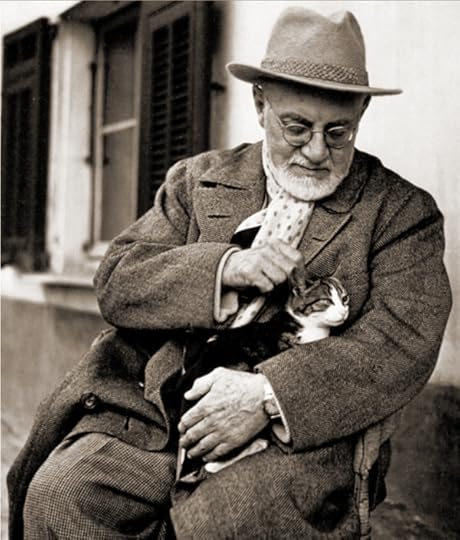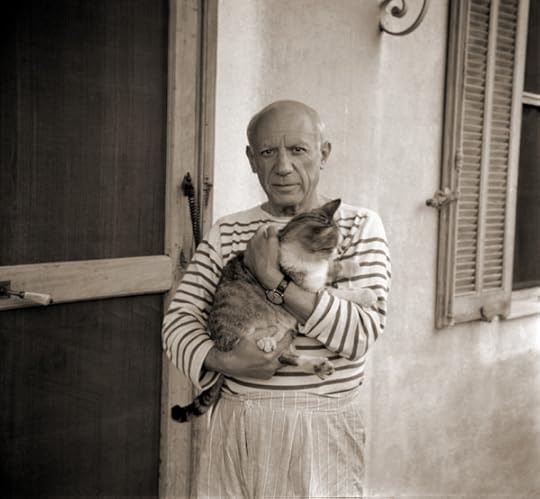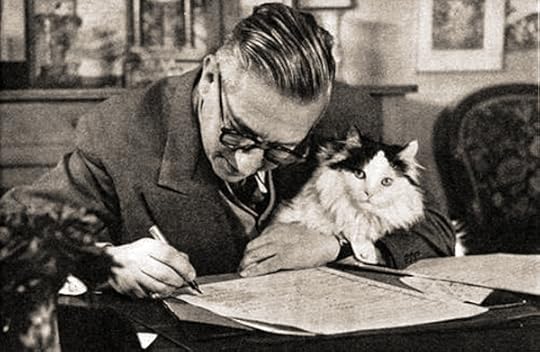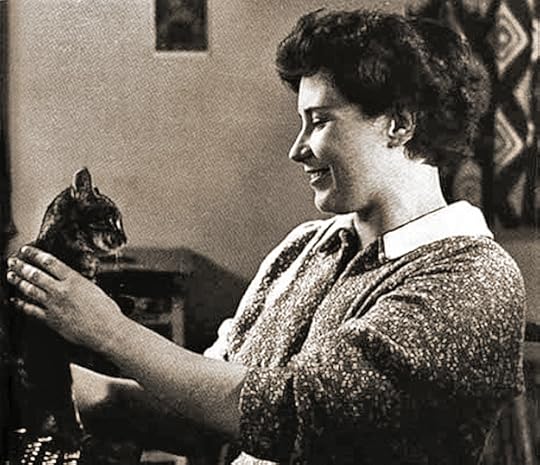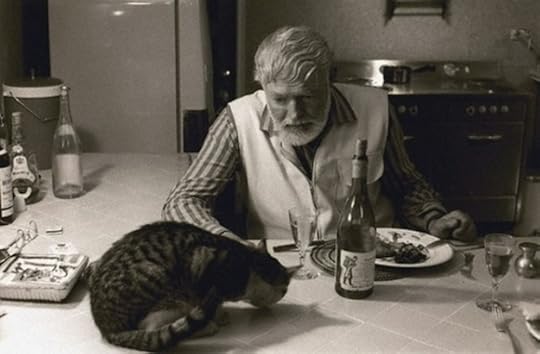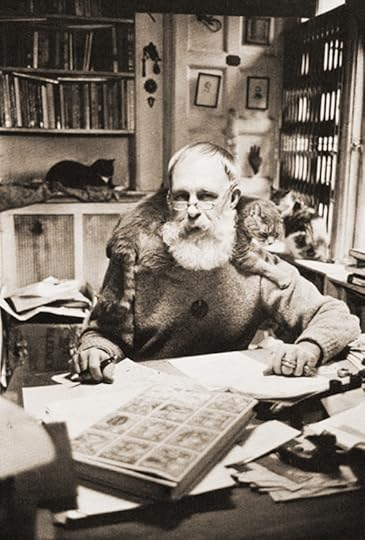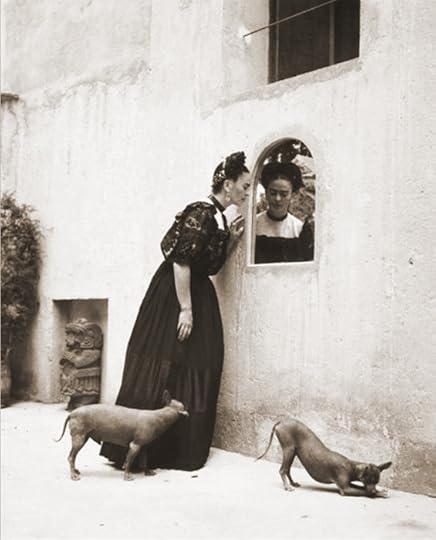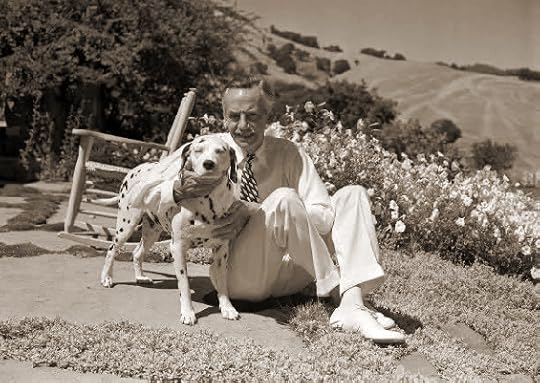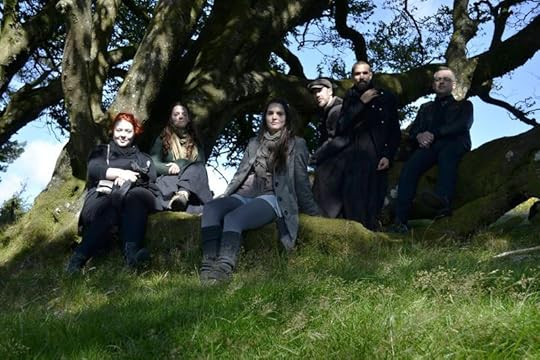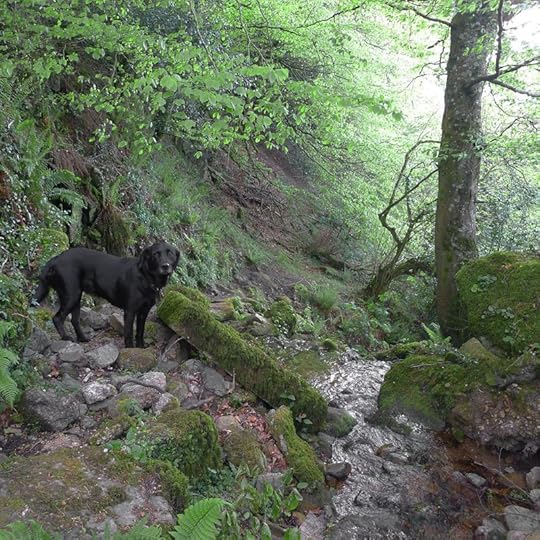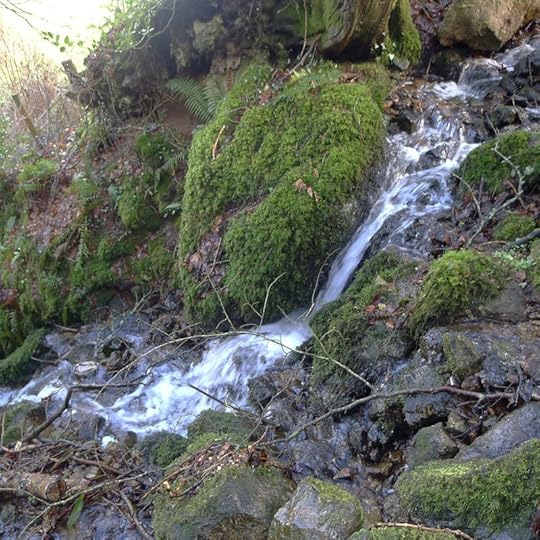Terri Windling's Blog, page 180
September 24, 2013
"Libraries are the best literacy resource we have," say...
"Libraries are the best literacy resource we have," says Malorie Blackman (the current Children's Laureate of Great Britain) in a recent article penned for The Guardian. "For children they
provide an equaliser that allows everyone access to books, story-telling
sessions, homework clubs; expert librarians who give non-partisan
assistance and advice regarding books; and warm and safe environments
within which to discover and explore the world of literature. Libraries
switch children on to a love of reading, with all the ensuing benefits,
and can make them lifelong readers. Without them, literacy may
increasingly become the province of the lucky few, rather than the
birthright of everyone."
"Libraries," as Rebecca Solnit describes them, "are sanctuaries from the world and command centers onto it:
here in the quiet rooms are the lives of Crazy Horse and Aung San Suu
Kyi, the Hundred Years' War and the Opium Wars and the Dirty War, the
ideas of Simone Weil and Lao-Tzu, information on building your sailboat
or dissolving your marriage, fictional worlds and books to equip the
reader to reenter the real world. They are, ideally, places where
nothing happens and where everything that has happened is stored up to
be remembered and relived, the place where the world is folded up into
boxes of paper. Every book is a door that opens onto another world,
which might be the magic that all those children's books were alluding
to, and a library is a Milky Way of worlds."
'A great library doesn't have to be big or beautiful," Vicki Myron points out. "It doesn't have
to have the best facilities or the most efficient staff or the most
users. A great library provides. It is enmeshed in the life of a
community in a way that makes it indispensable. A great library is one
nobody notices because it is always there, and always has what people
need.''
"Libraries are a force for good," says Libba Bray. "They wear capes. They fight evil. They
don’t get upset when you don’t send them a card on their birthdays.
(Though they will charge you if you’re late returning a book.) They
serve communities. The town without a library is a town without a soul.
The library card is a passport to wonders and miracles, glimpses into
other lives, religions, experiences, the hopes and dreams and strivings
of all human beings, and it is this passport that opens our eyes and
hearts to the world beyond our front doors, that is one of our best
hopes against tyranny, xenophobia, hopelessness, despair, anarchy, and
ignorance. Libraries are the torch of the world, illuminating the path
when it feels too dark to see. We mustn’t allow that torch to be
extinguished."
Thinking about libraries, I'm reminded of this lovely passage from Sarah Smith's Chasing Shakespeare: "I shall tell you what I believe. I believe God is a librarian. I
believe that literature is holy...it is that best part of our souls that
we break off and give each other, and God has a special dispensation
for it, angels to guard its making and its preservation."
Amen.
And yet libraries are now closing at a horrifying rate....and this will only get worse if we don't take immediate action in the UK, the US, and around the world. (Follow the links to organizations fighting the good fight.)
"Libraries are the thin red line between civilization and barbarism," says Neil Gaiman.
A call to arms if I ever heard one.
The images above: "Reading is an Advemture" by Charles Vess; "From the Library" by Michelle Knudsen; "Library Mouse" by Daniel Kirk; a photograph from CODE's "Adopt a Library" program;"Reading Matter" by Cassia Beck and"Things I Need to Survive" from The Lady of the Books; a photopgraph of a library bombed in the Blitz, London, 1940; and a poster design for The Stockbridge Library by Norman Rockwell.
September 23, 2013
Tunes for a Monday Morning
Today: The Proclaimers (those two irresistible Scottish lads) on the road to Vegas for their song "Let's Get Married." This one's for Howard, because it's our wedding anniversary today and this is a song we listened to at least a million times back when we did the scary deed of tying the knot and officially becoming a family.
Does every couple have songs that makes each think of the other? The one that never fails to make me think of my husband is Dougie MacLean's "This Love Will Carry," particularly after the things we've weathered as a family in the last few years. It's not a sweet song, but one about going through the dark of the woods together...for don't we all make that fairy tale journey at some point (or several points) in our lives? When we can do it hand in hand, that's a blessing indeed. In his performance below, MacLean (also from Scotland) is joined by the wonderful Appalachian American singer and musician Kathy Mattea. It is one of the most beautiful songs I know.
And now let me raise a glass to all of you and your loved ones too.
September 20, 2013
For our feline friends
According to one old legend, cats were the
only creatures on earth who were not made by God at the time of Creation.
When God covered the world with water, and Noah set his ark afloat, the
ark became infested with rats eating up the stores of food. Noah prayed
for a miracle, and a pair of cats sprang to life from the mouths of the
lion and lioness. They set to work, and quickly dispatched all the rats
— but for the original two. As their reward, when the boat reached dry
land the cats walked at the head of the great procession of Noah's animals.
Which is why, the legend concludes, all cats are proud, to this very day.
In the earliest feline images found on cave
walls and carved out of stone, wildcats are companions and guardians to
the Great Goddess — often flanking a mother goddess figure in the act
of giving birth. Such imagery has been found in ancient sites across Europe,
Africa, India and the Middle East. In China the lion, Shih, is one of
the four principal animal protectors — associated with rain, guardian
of the dead and their living descendants. In the New World, evidence of
wildcat cults is found across Central and South America, where the jaguar
was the familiar of shamans and a powerful totemic animal. Ai apaec of
the Mochica people of Peru was a much-revered feline god, pictured in
the shape of a wrinkle-faced old man with long fangs and cat whiskers.
A hauntingly beautiful wood carving of a kneeling figure with the head
of a cat was found just off the Florida coast — remarkably well preserved,
the image dates back over three thousand years.
We find the first evidence of the wildcat's
small cousin, Felis catus, in ancient Egypt — where the beasts were so
sacred that any man who killed one was condemned to death. When a house
cat died, the entire family shaved its eyebrows as a sign of grief; and
mummified cats (along with tiny mummified mice) have been found in Egyptian
tombs. In the 1st century BC, the Greek historian Diodorus reported the
fate of a hapless Roman who'd caused the death of a cat:
"The populace
crowded to the house of the Roman who had committed the 'murder'; and
neither the efforts of the magistrates sent by the King to protect him
nor the universal fear inspired by the might of Rome could avail to save
the man's life, though what he had done was admitted to be accidental.
This is not an incident which I report from hearsay, but something I saw
myself during my sojourn in Egypt."
Mau was the Egyptian word for cat
— both an imitation of its speech, and a mother-syllable. Bast, the Cat-mother,
was a goddess whose cult began in the delta city of Bubastis and eventually
covered all of Egypt with the rise of the XXII Dynasty. Unlike the fierce
lion-headed Sekmet from earlier Egyptian myth, Bast embodied the benevolent
aspects of cats: fertility, sexuality, love and life-giving heat. Bronzes
from the period show the goddess in her feline form (seated and wearing
earrings), as well as in human form with the head of a cat, kittens at
her feet. The twice-annual Festivals of Bast, as described by Herodotus,
were carnivals of music, dancing, wine-drinking, love-making and religious
ecstasy — dedicated to Bast in her aspect as Mistress of love and the
sensual pleasures.
Numerous legends tell of human beings who
transform into the shape of a cat. Although some male wizards, magicians
and shamans were gifted with this power, more commonly the shapeshifter
was a woman, and a witch. Cats (along with bats, owls and toads) were
believed to be witches' companions who aided in spells and carried messages to the Devil. During the tragically widespread witch trials of 16th and 17th century Europe, feline "familiars" were burned, hung, and drowned alongside their mistresses. A witch, it was said, could
shape-shift into cat form whenever the moon was full. Good men were advised
to lay consecrated salt on their doorstep, lest witches compel
them to join in their revels.
When we turn from folklore to fairy tales, shape-shifting
cats are viewed as less sinister creatures. In "The White Cat," a popular French fairy tale by Madame
d'Aulnoy, the three sons of a king are sent upon a series
of quests. The youngest son meets a lovely white cat, the queen of an
enchanted castle filled with cat-servants and courtiers. She helps the
prince with his tasks, and over time he falls in love with her. In the
end, she asks him to cut off her head; sadly, the young prince obeys her
command. This breaks the spell, and the cat assumes her true shape as
a human princess. (For a thoroughly modern rendition of the tale, I recommend Holly Black's YA novel, The White Cat.)
In "Kip the Enchanted Cat," from Russia, a mother cat
and her kitten are actually human beings under a fairy's curse. The
kitten is raised with a human princess and eventually aids her with several
magical tasks, leading to the spell's undoing and
a double wedding with two suitable princes. (This tale — about women's
friendships — was a particular favorite of mine as a child.)
"The Cat
Bride" is a story of animal-transformation in reverse: a house cat becomes
the human bride of a good and gentle man who allows the gossip of neighbors
to undermine his marital contentment. (I recommend Jane Yolen's lovely retelling in her story collection Dream Weaver.)
"Silvershod" (from Russia) is the tale of a poor man, a child, her beloved cat Moura, and a mysterious stag who sheds jewels in
the snow. The fairy tale ends oddly, for the jewels bring prosperity but the dear little cat vanishes with the stag. In a bittersweet poem inspired by the fairy tale, Ellen Steiber writes:
In the north country
a child wakes in a soft feather bed
and remembers
a red-brown cat
whose nose was cold against her neck.
In the north country
a child sits in a tall, gabled house
and remembers a pale gray stag
with a silver hoof
who gave and took
what was most precious.
 William S. Burroughs and Ginger
William S. Burroughs and Ginger
The best known fairy tale cat of them all, of course, is that clever, bold
rascal called "Puss in Boots." The story as we know it now comes
from the French
version penned by Charles Perrault in the 17th century; in earlier
versions -- such
as those of Straparola and Basile in Italy -- Puss is just as
wily, but
hasn't yet taken to wearing his famous boots. In a Scandinavian
version, "Lord Peter," our plotting Puss is female, and is really a princess under a troll's evil curse --
but in most tales, Puss is a cat, nothing more, albeit a very magical cat. (The bawdiest and best retelling, in my opinion, is Angela Carter's, in The Bloody Chamber.)
In additional to Puss in Boots and other memorable rogues from folklore and fairy tales, cats stalk through the pages of books beloved by children and adults alike.Who could forget the grinning
Cheshire Cat met by Alice
in Wonderland, or poor hungry Simpkin in Beatrix Potter's The
Tailor of Gloucester? Or Rudyard Kipling's The
Cat Who Walks by Himself, padding his way through the Just So Stories?
Or Edward Lear's The
Owl and the Pussy Cat, setting to sea in their pea-green boat?
Or T.S. Eliot's dashing Growltiger in Old
Possum's Book of Practical Cats? Or Mehitabel,
friend to Archy the cockroach, in the poems of Don Marquis? Or the wily cats in Nicholas Stuart Gray's classic children's stories: Grimbold's Other World,
The Stone Cage and Mainly in Moonlight?
In 1817, the American author Washington Irving paid a visit to
Scottish author and folklorist Sir Walter Scott. The following comes
from Irving's account
of that meeting, published in 1835:
"The evening passed delightfully in
a quaint-looking apartment, half-study, half-drawing room. Scott read
several passages from the old romance of Arthur, with a fine deep sonorous
voice, and a gravity of tone that seemed to me to suit the antiquated,
black-letter volume. It was a treat to hear such a work, read by such
a person, and in such place; and his appearance as he sat reading, in
a large armed chair, with his favorite hound Maida at his feet, and surrounded
by books and relics, and border trophies, would have formed an admirable
and most characteristic picture. While Scott was reading, the sage grimalkin
[Scott's cat] had taken his seat in a chair by the fire, and remained
with fixed eye and grave demeanor, as if listening to the reader. I observed
to Scott that his cat seemed to have a black-letter taste in literature.
"'Ah,' said he, 'these cats are very mysterious
kind of folk. There is always more passing in their minds than we are
aware of. It comes no doubt from their being so familiar with witches
and warlocks.' He went on to tell a little story about a gude man who
was returning to his cottage one night, when, in a lonely out-of-the-way
place, he met with a funeral coffin covered with a black velvet pall.
The worthy man, astonished and half frightened at so strange a pageant,
hastened home and told what he had seen to his wife and children. Scarce
had he finished, when a great black cat that sat by the fire raised himself
up, exclaimed, 'Then I am king of the cats!' and vanished up the chimney.
The funeral seen by the gude man was one of the cat dynasty. "'Our grimalkin
here,' added Scott, 'sometimes reminds me of the story, by the airs of
sovereignty which he assumes; and I am apt to treat him with respect from
the idea he may be a great prince incognito, and may some time or other
come to the throne.'"
"Authors like cats," said Robertson Davies, "because they are such quiet, loveable, wise creatures. And cats like authors for the same reasons."
 Holly Black and her hairless cat
Holly Black and her hairless cat
To end with: two photos of Howard with my beloved cat Oliver at my old place in Arizona, 2008. I'd found Oliver as a starving kitten on the streets of Boston (in the late 1980s), and he was with me for twenty years -- a tough, fiesty, big-hearted fellow. I still miss him.
September 19, 2013
A Dog's Life, Part II
 Maurice Sendak and Melvin
Maurice Sendak and Melvin
Refections on community, literature, and language by Marilynne Robinson (from When I Was a Child I Read Books):
"I would say, for the moment, that community, at least community larger than the immediate family, consists largely of imaginative love for people we do not know or whom we know very slightly. This thesis may be influenced by the fact that I have spent literal years of my life lovingly absorbed in the thoughts and perceptions of -- who knows it better than I? -- people who do not exist. And, just as writers are engrossed in the making of them, readers are
profoundly moved and also influenced by the nonexistent, that great clan
whose numbers increase prodigiously with every publishing season. I
think fiction may be, whatever else, an exercise in the capacity for
imaginative love, or sympathy, or identification.
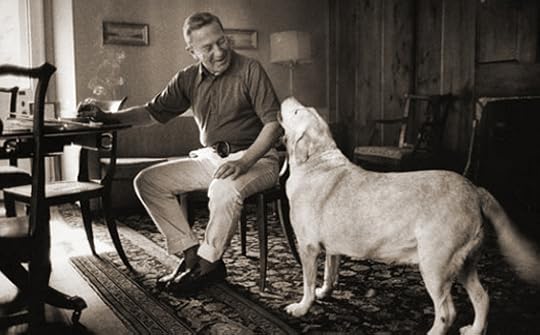 John Cheever and Flora
John Cheever and Flora
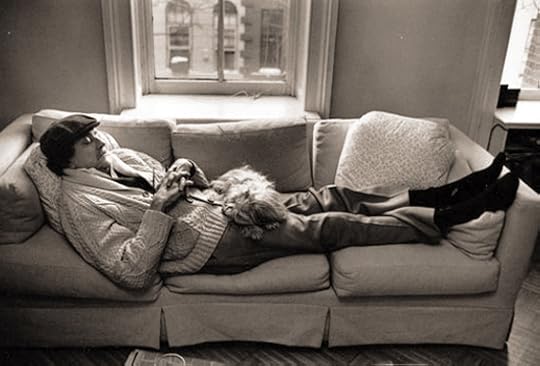 Kurt Vonnegut and Pumpkin
Kurt Vonnegut and Pumpkin
"I love the writers of my thousand books. It pleases me to think how astonished old Homer, whoever he was, would be to find his epics on the shelf of such an unimaginable being as myself, in the middle of an unrumored continent. I love the large minority of the writers on my shelves who have struggled with words and thoughts and, by my lights, have lost the struggle.
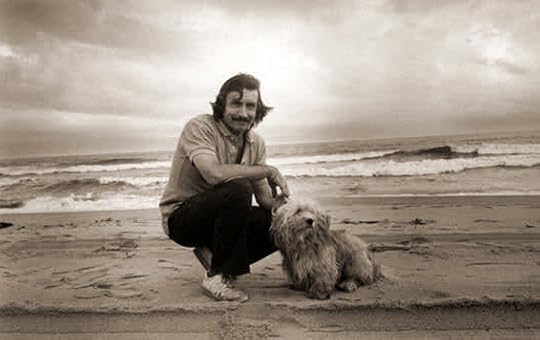 Edward Albee and Poochi
Edward Albee and Poochi
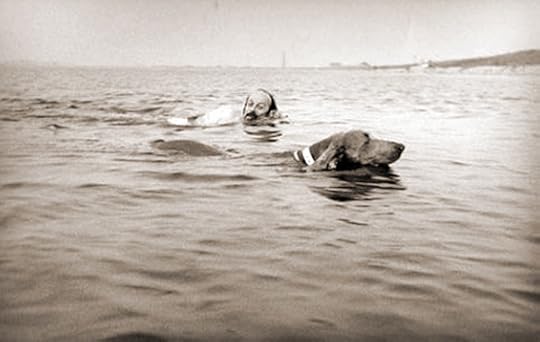 E.L. Doctorow and Becky
E.L. Doctorow and Becky
"All together they are my community, the creators of the very idea of
books, poetry, and extended narratives, and of the amazing human
conversation that has taken place across millennia, through weal and
woe, over the heads of interest and utility.
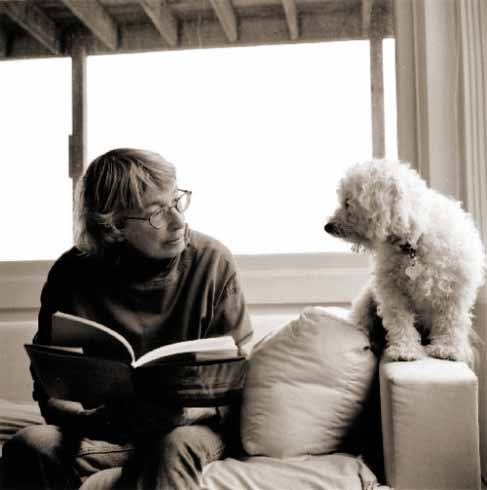 Mary Oliver and Percy
Mary Oliver and Percy
 John Katz and one of the dogs of Bedlam Farm
John Katz and one of the dogs of Bedlam Farm
"We live on a little island of the articulable, which we tend to mistake
for reality itself. We can and do make small and tedious lives as we
sail through the cosmos on our uncannily lovely little planet, and this
is surely remarkable. But we do so much else besides.
 Ann Patchett and Rose
Ann Patchett and Rose
 Amy Tan and Bubba Zo
Amy Tan and Bubba Zo
"For example, we make language. A language is a grand collaboration, a collective art form that we begin to master as babes and sucklings, and which we preserve, modify, cull, enlarge as we pass through our lives....
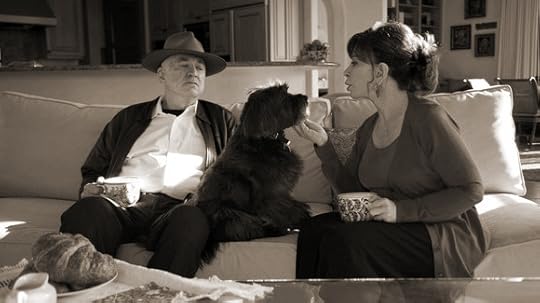 Isabel Allende, her husband, and Olive
Isabel Allende, her husband, and Olive
 Stephen King
and Marlowe
Stephen King
and Marlowe
"One of the pleasures of writing is that so often I know that there is
in fact a word that is perfect for the use that I want to put it to, and
when I summon it it comes, though I might not have thought of it for
years. And then I think, somewhere someone was the first person to use
that word. Then how did it make its way into the language, and how did
it retain the specificity that makes it perfect for the present use? Language is profoundly communal, and in the mere fact of speaking, then
writing, a wealth of language grows and thrives among us that has
enabled thought and knowledge in a degree we could never calculate. As
individuals and as a species, we are unthinkable without our
communities.
 Jonathan Carroll
and Jack
Jonathan Carroll
and Jack
 Neil Gaiman
and Cabal
Neil Gaiman
and Cabal
"I remember once, as a child, walking into a library, looking around at the books, and thinking, I could do that. In fact I didn't do it until I was well into my thirties, but the affinity I felt with books as such preserved in me the secret knowledge that I was a writer when any dispassionate appraisal of my life would have dismissed the notion entirely.
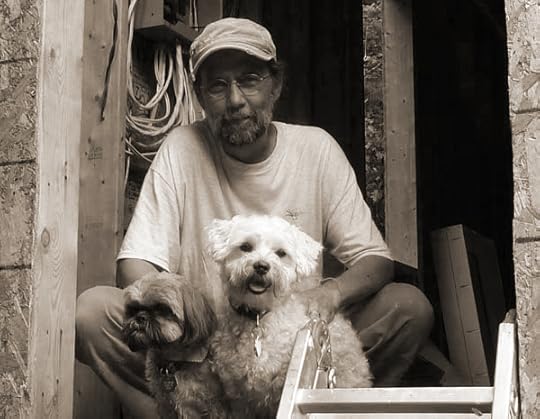 Charles de Lint with Johnny Cash (white fur) and friend
Charles de Lint with Johnny Cash (white fur) and friend
 Alice Hoffman
and Houdini
Alice Hoffman
and Houdini
"So I belong to the community of the written word in several ways. First,
books have taught me most of what I know, and they have trained my
attention and my imagination. Second, they gave me a sense of the possible, which is the great service -- and too often, when it is ungenerous, the great disservice -- a community performs for its members. Third, they embodied richness and refinement of language in the service of the imagination. Fourth, they gave me and still give me courage.
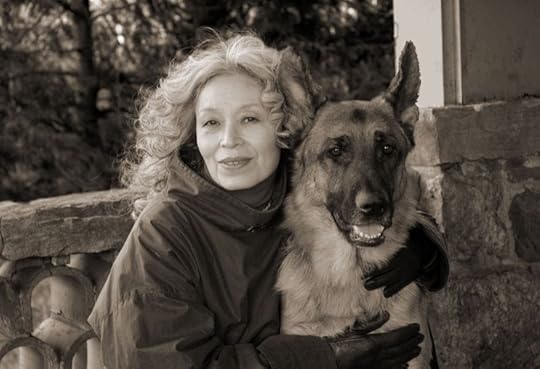 Kinuko Y. Craft and Wolfgang
Kinuko Y. Craft and Wolfgang
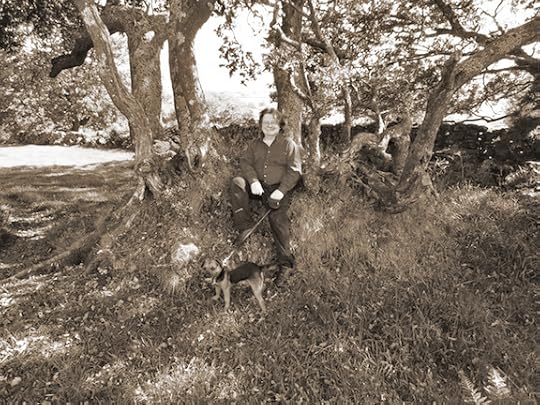 Brian Froud and Elfie
Brian Froud and Elfie
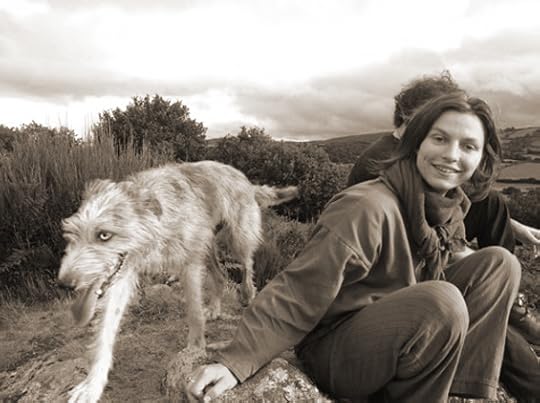 Rima Staines and Macha
Rima Staines and Macha
"Sometimes, when I have spent days in my study dreaming a world while the world itself shines outside my windows, forgetting to call my mother because one of my nonbeings has come up with a thought that interests me, I think, this is a very odd way to spend a life. But I have my library all around me, my cloud of witnesses to the strangeness and brilliance of human experience, who have helped me to my deepest enjoyment of it. Every writer I know, when asked how to become a writer, responds with one word: Read. Excellent advice, for a great many reasons, a few of which I have suggested here."
 Taiko Maria Haessler and Buju (in puppyhood)
Taiko Maria Haessler and Buju (in puppyhood)
 Howard Gayton and Tilly
Howard Gayton and Tilly
Tomorrow: the cats' turn.
September 18, 2013
A Dog's Life
Writing advice from Marilynne Robinson (When I Was Young I Read Books):
"There is a great difference, in fiction and in life, between knowing someone and knowing about someone. When a writer knows about his character he is writing for plot. When he knows his character he is writing to explore, to feel reality on a set of nerves somehow not quite his own.
"Words like 'sympathy,' 'empathy,' and 'compassion' are overworked and overcharged -- there is no word for the experience of seeing an embrace at a subway stop or hearing an argument at the next table at a restaurant. Every such instant has its own emotional coloration, which memory retains or heightens, and so the most sidelong unintended moment becomes a part of what we have seen of the world.
"Then, I suppose, these moments, as they have seemed to us, constellate
themselves into something a little like a spirit, a little like a human
presence in its mystery and its distinctiveness.
"Two questions I can't really answer about fiction are (1) where it
comes from and (2) why we need it. But that we do create it and also
crave it is beyond dispute.
"There is a tendency, considered highly
rational, to reason from a narrow set of interests, say survival and
procreation, which are supposed to govern our lives, and then to treat
everything that does not fit this model as anomalous clutter, extraneous
to what we are and probably best done without. But what we really know
about what we are is what we do. There is a tendency to fit a tight and
awkward carapace of definition over humankind, and to try to trim the
living creature to fit the dead shell.
"The advice I give my students is
the same advice that I give myself -- forget definition, forget
assumption, watch. We inhabit, we are part of, a reality for which
explanation is much too poor and small. No physicist would dispute this,
though he or she might be less ready than I am to have recourse to the
old language and call reality miraculous.
"By my lights, fiction that
does not acknowledge this at least tacitly is not true."
 Theodor Seuss Geisel (Dr. Seuss) and Cluny
Theodor Seuss Geisel (Dr. Seuss) and Cluny
More dogs (and a few cats) tomorrow.
September 17, 2013
On Dartmoor...
For his book The Wild Places, Robert Macfarlane journeyed to Britain's remaining wilderness areas -- including Ranoch Moor, a large stretch of bog and heath to the west of Loch Rannoch in Scotland. His reflections on moorland, and the importance of open space, could easily apply to Dartmoor as well:
"In a land as densely populated as Britain," writes Macfarlane, "openness can be hard to find. It is difficult to reach places where the horizon is experienced as a long unbroken line, or where the blue of distance becomes visible. Openness is rare, but its importance is proportionately great. Living constantly among streets and houses induces a sense of enclosure, of short-range sight. The spaces of moors, seas and mountains counteract this.
"Whenever I return from the moors, I feel a lightness up behind my eyes,
as though my vision has been opened out by twenty degrees to either
side. A region of uninterrupted space is not only a convenient metaphor
for freedom and openness, it can sometimes bring those feelings fiercely
on.
"To experience openness is to understand something of what the American novelist Willa Cather, who was brought up on the Great Plains, called 'the reaching and reaching of high plains, the immeasurable yearning of all flat lands.' To love open spaces -- and they have, historically, not been loved -- you have to believe, as Cather did, that beauty might at times be a function of continuous space. You have to believe that such principles might possess their own active expansiveness. Anyone who has been in an empty sea, out of sight of land, on a clear day, will know the deep astonishment of seeing the curvature of the globe: the sea's down-turned edges, its meniscal frown.
"Open space brings to mind something that is difficult to express, but unmistakeable to experience....The influence of spaces such as the moor cannot be measured, but should not for this reason be passed over. 'To recline on a stump of thorn, between afternoon and night,' Thomas Hardy wrote in The Return of the Native, 'where the eye could reach nothing of the world outside the summits and and shoulders of heathland which filled the whole circumferance of its glance, and to know everything around and underneath has been from prehistoric times as unaltered as the stars overhead, gave ballast to the mind adrift on change, and harrassed by the irrepressible New."
In The Solace of Open Spaces, Gretel Ehrlich, based in the Big Sky country of Wyoming, writes: "The truest art I would strive for in any work would be to give
the page the same qualities as earth: weather would land on it harshly,
light would elucidate the most difficult truths; wind would sweep away
obtuse padding."
"Something will have gone out of us as a people if we ever let the
remaining wilderness be destroyed," said the American historian and novelist Wallace Stegner (1900-1993)."We simply need that wild country
available to us, even if we never do more than drive to its edge and
look in.”
And indeed we do.
The beautiful Dartmoor photographs above were taken last week by our friend David Thiérrée, when he and five other French mythic artists from Brittany came to walk the moor and visit our community of mythic artists in Chagford. In the photo below (left to right) is Virginie Ropars, Claire Briant, Alice Dufeu, Olivier Villoingt, Yoann Lossel, and David himself. Please follow the links to see their enchanting artwork.
September 16, 2013
Exploring the neighborhood
“I am no scientist. I explore the neighborhood. An infant who has just
learned to hold up his head has a frank and forthright way of gazing
about him in bewilderment. He hasn’t the faintest clue where he is, and
he aims to find out. In a couple of years, what he will have learned
instead is how to fake it: he’ll have the cocksure air of a squatter who
has come to feel he owns the place. Some unwonted, taught pride
diverts us from our original intent, which is to explore the
neighborhood, view the landscape, to discover at least where it is that
we have been so startlingly set down, if we can’t learn why." - Annie Dillard (Pilgrim at Tinker's Creek)
I don't know exactly what a prayer is.
I do know how to pay attention, how to fall down
into the grass, how to kneel down in the grass,
how to be idle and blessed, how to stroll through the fields,
which is what I have been doing all day.
Tell me, what else should I have done?
Doesn't everything die at last, and too soon?
Tell me, what is it you plan to do
with your one wild and precious life?
- Mary Oliver ("The Summer Day," New and Selected Poems)
More and more I have come to admire resilience.
Not the simple resistance of a pillow, whose foam
returns over and over to the same shape, but the sinuous
tenacity of a tree: finding the light newly blocked on one side,
it turns in another. A blind intelligence, true.
But out of such persistence arose turtles, rivers,
mitochondria, figs – all this resinous, unretractable earth.
- Jane Hirshfield ("Optimism," Given Sugar, Given Salt)
"There is but one world and everything that is imaginable is necessary
to it. For this world also which seems to us a thing of stone and flower
and blood is not a thing at all but is a tale. And all in it is a tale
and each tale the sum of all lesser tales and yet these are also the
selfsame tale and contain as well all else within them. So everything is
necessary. Every least thing. This is the hard lesson. Nothing can be
dispensed with. Nothing despised. Because the seams are hid from us, you
see. The joinery. The way in which the world is made. We have no way to
know what could be taken away. What omitted. We have no way to tell
what might stand and what might fall. And those seams that are hid from
us are of course in the tale itself and the tale has no abode or place
of being except in the telling only and there it lives and makes its
home and therefore we can never be done with the telling. Of the telling
there is no end. And . . . in whatever . . . place by whatever . . .
name or by no name at all . . . all tales are one. Rightly heard all
tales are one." - Cormac McCarthy (The Crossing)
''To see that your life is a story while you're in the middle of living it may be a help to living it well." - Ursula K. Le Guin (Gifts)
September 15, 2013
Tunes for a Monday Morning
I've come to the studio feeling sleepy, befuddled, and a little overwhelmed by the demands of the work week ahead -- so I've chosen four tunes about sailors & pirates tunes to liven up the morning, kicking off the week with a jolly hey-ho!
Above: "Ten Thousand Miles Away" from John Boden's band, Bellowhead. Boden lives in rural Sussex, and other band members hail from all over the UK.
Below: a wonderfully silly video for "All You Pretty Girls," Jim Moray's folk version of a classic XTC song. Moray lives in Bristol, UK.
Next up:
"Pirate Song" by the fabulous Moulettes (performed for the BBC). The band started off in Glastonbury and is now based in Manchester, UK.
And last, but by no means least:
A raucous rendition of "Drunken Sailor" from the Hungarian-Irish band Firkin, based in Budapest.
Our one-eyed girl
This morning, poor Tilly has learned the hard way why she must never play with wasps. (Or maybe she's getting into today's pirate theme and is angling for an eye patch....)
September 14, 2013
The Dog's Tale
The Dog's Tales: a series of posts in which Tilly has her say....
All these fairy tale posts are well and good, but I admit to feeling neglected this week. I am, after all, the Muse of the studio (a role I perform to perfection, I think), yet for all the attention I've had here lately, you'd think I was just a dog.
Ah, but I must be patient. My People are artists, and artists are odd, absent-minded creatures, easily distracted. It is my job, as Muse, to take them in hand when they've strayed too far into imaginary realms...to bring them back to their physical senses, their animal bodies (why do People have so much trouble with this???), to the present moment and the everyday magic of the good smelly world around us.
So I push my cold nose into their hands and give them the stare that means: "Let's go for a walk." (My People cannot resist The Stare.)

"Okay, okay," they say at last, laughing, closing the computer,
putting down the book or paintbrush, and we head for the woods. People,
I've learned, must be walked at least twice a day if they're to stay
happy, healthy, and creative. (Use The Stare if your People resist it.)
I leave you with these words by Lao Tzu, which sums up my life philosophy:
"In dwelling, live close to the ground. In thinking, keep to the
simple. In conflict, be fair and generous. In governing, don't try to
control. In work, do what you enjoy. In family life, be completely
present.”
People know this. They just need to be reminded. And that's where we come in.
Terri Windling's Blog
- Terri Windling's profile
- 708 followers
















